By Andrew Pitts, AIA, LEED AP BD+C
In most states, the juvenile justice pendulum has swung away from the days of “three strikes” and scaring youth offenders straight. Yet while the way we address juvenile crime and truancy may be changing to more evidence-based models, many counties are challenged to deliver a new array of services within correctional facilities not designed for that purpose.
What’s changed within juvenile justice?
- States are looking at how to provide services that will treat and rehabilitate youth within their communities and set them on a path away from the adult judicial system. One by one, states are changing the rules on how they handle youth offenders and counties have been challenged to keep up.
- Secured facilities in many states continue to struggle with meeting federal Prison Rape Elimination Act (PREA) standards simply because their buildings do not allow implementation. Implementing these standards can vary depending on the facility’s physical layout. Typical concerns include blind spots, floor plans that don’t allow for counseling and other services, and physically managing minimum staff ratios that could impact the housing population.
- Additionally, more states are expanding the definition of juvenile offender to include those age 18 or even 19. Research by the MacIver Institute and Texas Public Policy Foundation, as well as the Centers for Disease Control, finds that addressing youth crime in juvenile versus adult court would reduce reoffending by as much as 34%.
- The juvenile population is changing. Youth who enter the juvenile justice system today are more likely to present with mental health concerns and substance abuse issues, and have experienced significant trauma and violence. Many counties are also seeing more female offenders.
None of these changes come with designated funding, and it can be difficult for cash-strapped counties to find the money to address them. Increasingly though, tax referendums and re-allocations of existing resources for improved youth facilities have been successful.
How counties are meeting the challenge
As counties implement new programs and services to address juvenile offenders, there is a great need to change how their buildings are working to address these changing policies.
A shift to more community-based, family-involved treatment requires an environment that is not only safe and secure, but humane, child-centered and flexible enough to allow the delivery of a range of services.
In Jasper County, Missouri, necessity prompted the building of a new juvenile justice facility. In 2015, coming off four successful years participating in the Juvenile Detention Alternatives Initiative (JDAI) funded by the Annie E. Casey Foundation, its juvenile facility was shut down due to fire code violations. When taxpayers agreed to fund a new building through a sales tax referendum, the county had a vision of a facility that built on its successes.
“We did not want to simply provide offices and detention space,” said Erik Theis, Court Administrator of the 29th Judicial Circuit Court. “We wanted to create a facility that is on the cutting edge of juvenile justice practices. We are building to last 20 years.”
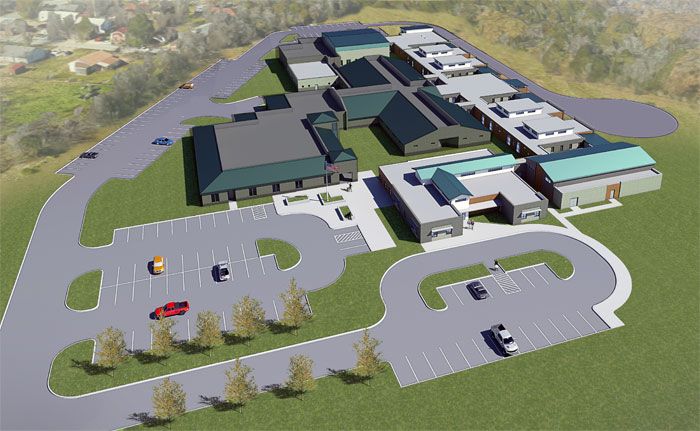 Brazos County Juvenile Services has been evolving from a correctional detention model toward a more treatment-based model. (Photo/Treanor HL)
Brazos County Juvenile Services has been evolving from a correctional detention model toward a more treatment-based model. (Photo/Treanor HL)
Likewise, Brazos County, Texas – one of the fastest growing counties in the nation – is trying to stay ahead of the curve by expanding its Juvenile Justice Center. Coupled with a potential change in age jurisdiction, Doug Vance, Executive Director of Brazos County Juvenile Services, sees a big boom coming in the population his department serves, and they are preparing to meet it.
In Virginia, Lynchburg’s Juvenile Services Group Home staff has been stretched thin transporting youth and providing services from three different locations. It was expensive and inefficient, calling for a more streamlined approach.
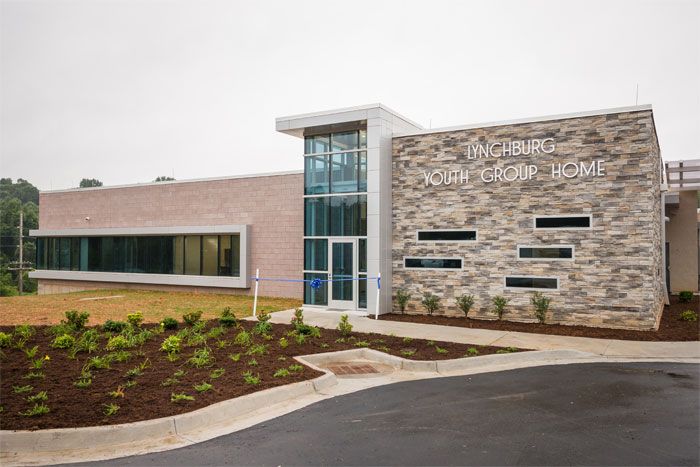 Lynchburg’s new Group Home provides a stepping stone for juveniles leaving detention. (Photo/Treanor HL)
Lynchburg’s new Group Home provides a stepping stone for juveniles leaving detention. (Photo/Treanor HL)
Each of these three counties has unique challenges and operations, but they are turning to the following common themes when addressing them.
1. Trauma-informed design
The modern juvenile justice facility looks more like a school or community center than a jail –and that’s by intention. These are durable, safe facilities with plenty of security, but the feel is less institutional and more familiar. Natural light, softer colors and furnishings make facilities feel more like classrooms than detention spaces. At the same time, they offer clear lines of sight and layouts that allow for efficient use of staff resources and strong supervision.
Private courtyards and secured outdoor spaces provide access to fresh air without compromising child confidentiality or safety. More traditional detention facilities, such as the one in Brazos County, are also moving toward a more humane, normalized environment that does not re-traumatize children who may come from difficult circumstances. These are not elaborate buildings, but public service facilities designed to help youth get back on track.
“We wanted to design a facility that was as much of a home-like atmosphere as possible, one that was conducive to kids feeling safe and could provide treatment, as well as recreation and education – all the things that kids have access to outside of this system,” said Tamara Rosser, Director of Lynchburg’s Group Home.
2. One-site service delivery
Lynchburg’s new Group Home was built next door to its existing juvenile detention center, creating a campus that streamlines operations. Previously, Juvenile Services operated out of three 1800-era buildings, making supervision and transportation challenging. Today, its non-secure, 24-bed, co-ed group home provides a stepping stone for juveniles leaving detention and a first stop for children who have committed low-level violations. The facility aims to be a one-stop shop, also providing counseling, family services and educational classes.
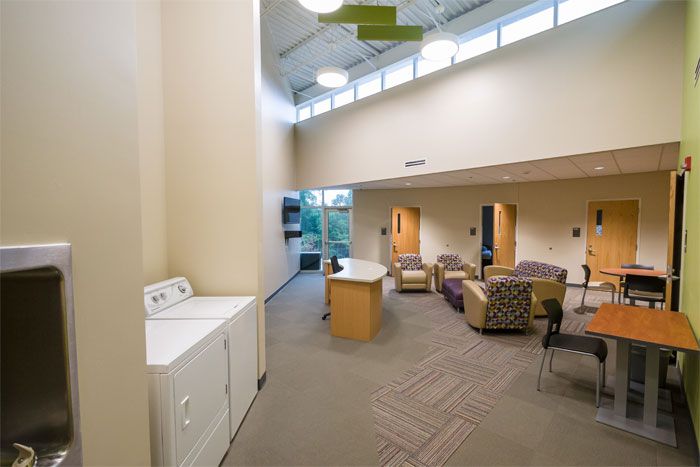 The modern juvenile justice facility looks more like a school or community center than a jail. (Photo/Treanor HL)
The modern juvenile justice facility looks more like a school or community center than a jail. (Photo/Treanor HL)
Jasper County’s new facility – also a one-stop shop of sorts – will now house its successful diversions court, started several years ago by the Hon. Gayle Crane, Circuit Judge in the 29th Judicial Circuit. While the program has shown results, it’s been challenging to administer within limited courtroom and detention space.
“This facility offers a casual, school-like setting where we can get away from that mentality of detention,” said Crane. “In the new facility, we can streamline that program very effectively.”
3. Separate, safer housing
The juvenile justice system has been adjusting its operations to accommodate the federal PREA guidelines. Designed to prevent sexual assaults and improve safety for vulnerable children, the new rules have shifted the Brazos County Detention Center’s child-to-staff ratio from 1:12 in daytime and 1:24 at night to 1:8 and 1:16, respectively. That means additional staffing and reconfigured housing pods.
The disparity of ages and offenses within the juvenile jurisdiction also predicates the need for separate, safe housing.
“We need to be able to separate out the older kids from the younger,” said Vance. “We don’t want 16- and 17-year-olds housed with 10-year-olds, and we need to be able to separate those with potential predatory behavior from those who may be vulnerable or easy prey.”
Add to that an increase in female offenders – Brazos County used to house an average of 4-6 girls at a time; today that’s doubled, and has been as high as 18 – and the growing need for multiple, flexible housing pods is clear.
4. Treatment-based programming and housing
In some counties, as many as 50% of youth in detention report some form of mental health issue, and that is fueling a move toward a treatment-based experience that addresses behavioral, psychological and emotional issues.
Newer facilities are increasingly incorporating special-needs housing pods designed to accommodate behavioral issues, mental illness, intellectual disabilities or special circumstances that may cause children to struggle within a regular detention environment.
In Texas, the juvenile justice system has been evolving from a correctional detention model toward a more treatment-based model for several years. To that end, Brazos County’s Juvenile Justice Center staff includes specialists in behavioral psychology, sex offender treatment, chemical dependency and medicine, as well as professional counselors and detention staff.
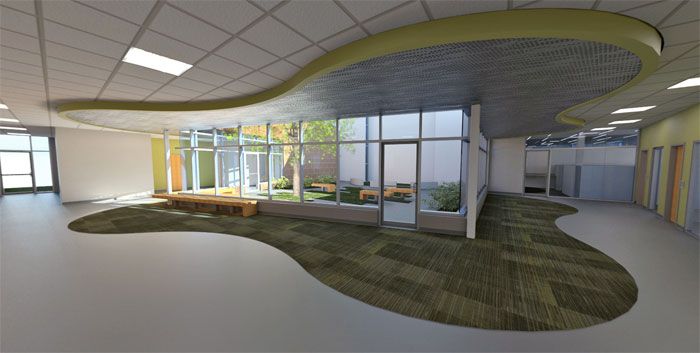 Facilities are welcoming, but they also offer clear lines of sight for efficient use of staff resources and strong supervision. (Photo/Treanor HL)
Facilities are welcoming, but they also offer clear lines of sight for efficient use of staff resources and strong supervision. (Photo/Treanor HL)
A carefully vetted screening system, coupled with specialized treatment planning, helps detained youth get the treatment they need so that they can move forward.
“In many cases, with juveniles it is more like habilitation,” Vance said. “They may never have learned anger management or conflict resolution. They may never have learned how not to succumb to peer pressures or manage social interaction, or how to manage their emotions. They need to learn those things so that they have a chance to rehabilitate and stay out of the adult justice system.”
5. Alternative educational space
Alternative day schools, where youth attend classes within a secured facility during the day and go home to their parents at night, are also growing in popularity as juvenile justice systems build closer alliances with local school districts.
Partnerships with local schools and colleges offer youth who may be truant or committing lower-level offenses focused attention to improve their educational outcomes. Brazos County’s new Juvenile Center includes an alternative education area that resembles a small-scale high school, with classrooms, a kitchen classroom, multi-purpose rooms, check-in, lockers, offices and private courtyard.
In Lynchburg, where a comprehensive educational intervention system currently exists, officials say they’d like to eventually extend those services up to age 21, via an independent live/study/work program.
“This is where we can help them grow and become law-abiding citizens and learn to respect the rights and property of others,” Dan Fallon, Assistant Director of Lynchburg Juvenile Services Group Home said.
“They need a mentor and support. If a child is in the foster system since age 9 or 10 and has never been adopted or ever had a stable foster home, how can we expect them to be out there on their own making good decisions?” asks Rosser.
6. Life-skills training
While it does include a courtroom and a detention center, more than half of the space in Jasper County’s new facility is allocated for services such as afterschool programming, life-skills training and special interest classes, such as guitar lessons and cooking instruction. Many of the classes and activities focus on building confidence and teaching simple skills that have been missing from their home life such as:
- Daily life skills, including simple meal preparation;
- Basic financial management skills;
- Wellness activities and exercise, such as karate or training for a 5K run;
- Healthy, interest-based hobbies such as guitar classes.
“While we are handling the youth who need to be detained because they are a danger to themselves and others, we also want to offer alternatives to detention that will lift these youth up so that they can become productive members of the community,” Theis said. “That is what is going to help them succeed, and many of these kids do not have this at home.”
7. Family involvement
Brazos County’s Juvenile Detention Center expansion is planning to double its current capacity to 64 beds and add eight security special-needs beds. The facility was also master-planned to include an additional 48 post-adjudication beds and six post-adjudication security housing beds. Currently, these youth are sent out of county and out of state, which costs more and hampers the department’s ability to work effectively with families – a factor that can be critical to rehabilitating youth offenders.
“We put a lot of emphasis on reunifying the family,” Lynchburg’s Rosser said. “The delinquency of a child can create rifts in a family. We can deal with the child’s issues here, but they still need to go back home. We try to enable the family to access the appropriate resources so that they are prepared for these kids to come home.”
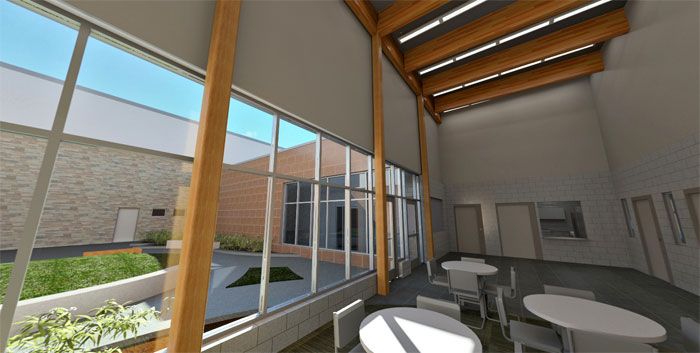 Private courtyards and secured outdoor spaces provide access to fresh air without compromising child confidentiality or safety. (Photo/Treanor HL)
Private courtyards and secured outdoor spaces provide access to fresh air without compromising child confidentiality or safety. (Photo/Treanor HL)
In Jasper County, Juvenile Officer Kelly Sales also involves families in social interactions to encourage bonding and improved family dynamics. Resident youth may use the kitchen or BBQ grill to learn to prepare food and invite their family to share a sit-down meal. An outdoor theater offers space for families to watch a movie together.
Making it happen
Funding is always a challenge – no matter what part of the country you’re operating in.
In Brazos County, 80% of juvenile justice funding is typically raised by the county, with the remaining 20% coming from the state. With an increase in age jurisdiction comes the need to hire more juvenile supervision staff and probation officers to handle the additional caseload. Serving an older population also requires more specialized needs, such as additional workforce and job skills, family services and the legal requirements for separation between age groups.
While sales tax referendums can be successful in raising funds to modernize facilities and meet capacity, it’s often an educational process. Sharing success stories is important – the young man who never thought he’d graduate successfully studying a trade, the family reunited and repaired, the improved recidivism rates and over-time cost savings. National-level research also helps counties to make a strong case.
In Jasper County, strong results helped win over taxpayers. Between 2011 and 2015, the county saw a 95% drop in the number of children detained and a 92% drop in the number of days they were held – an annual savings of approximately $2 million.
“A lot of research shows there are other ways to handle juvenile offenders, other than detention, that do not stigmatize these kids,” Theis said. “Many people understand that these are kids who have been dealt a bad hand in life. By providing them these services, the likelihood that they will become productive, tax-paying citizens increases, and that is a good thing for everybody.
“The important thing is that we are using research and data to drive our decisions. There will, of course, be changes in the programs we adopt or eliminate as we move forward, but we are making those decisions based on research and information, not on what we think or what we feel might be a good idea.”
About the Author
Andrew Pitts, AIA, LEED AP BD+C, is a Principal in TreanorHL’s Justice Studio.

